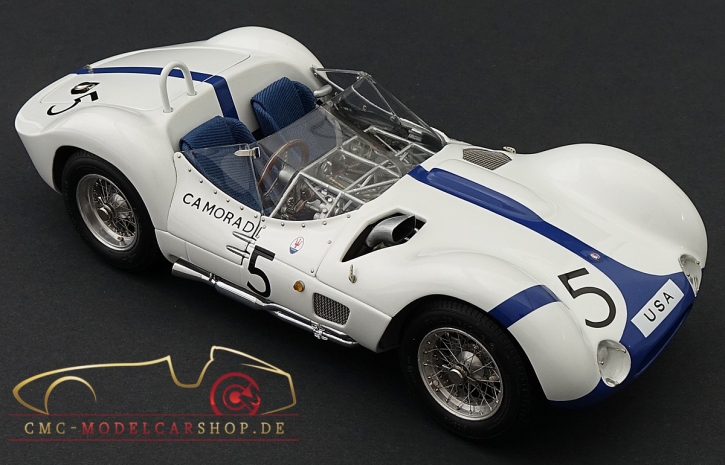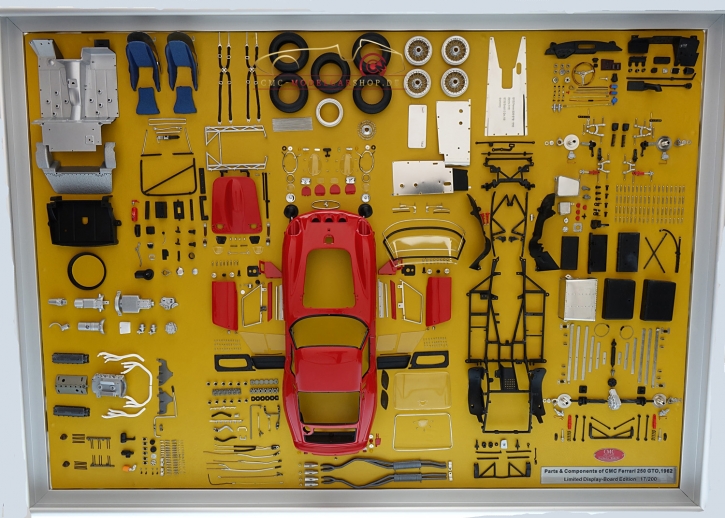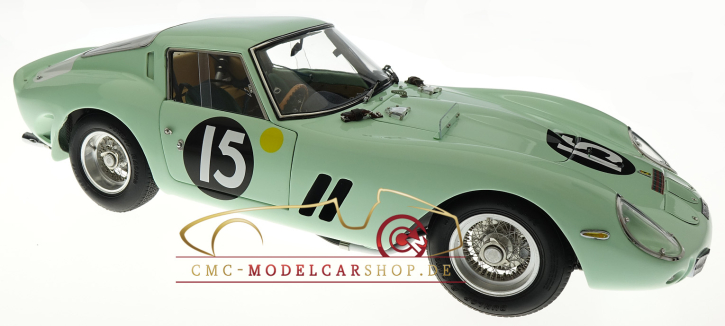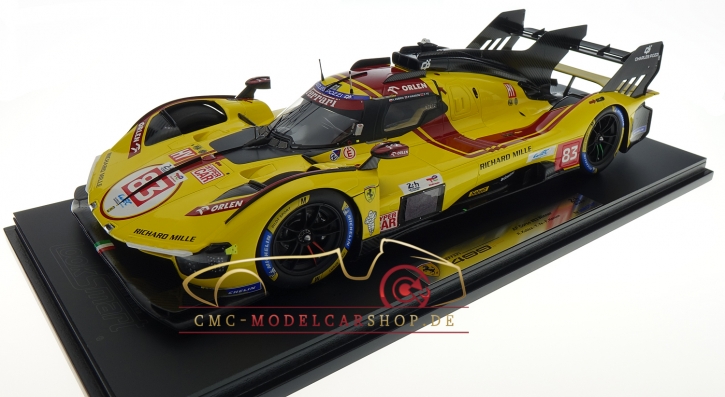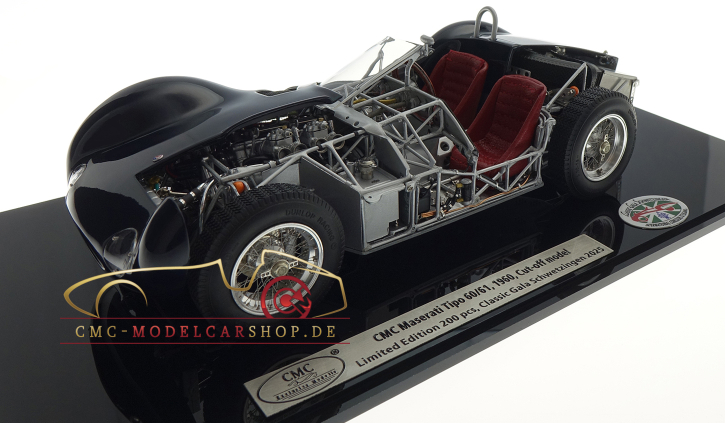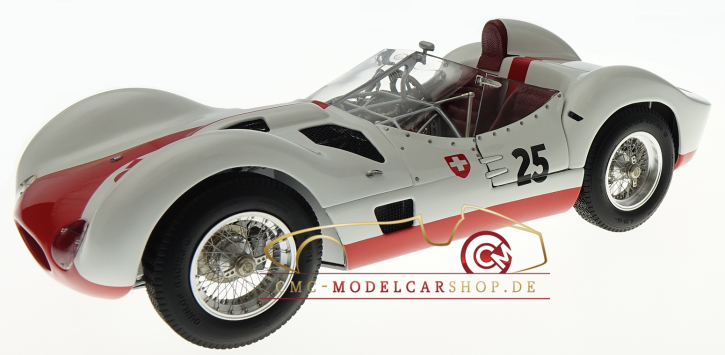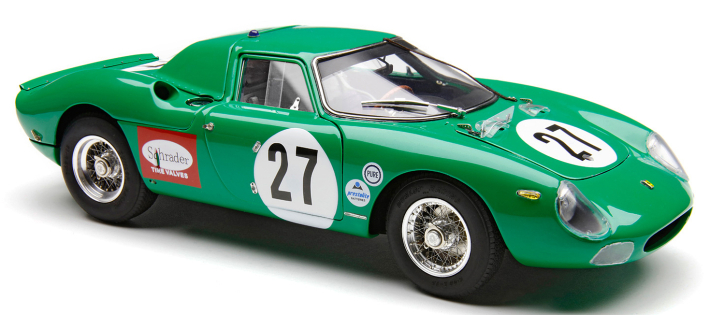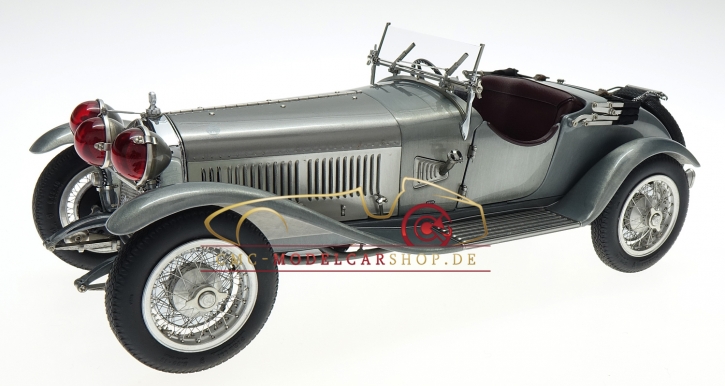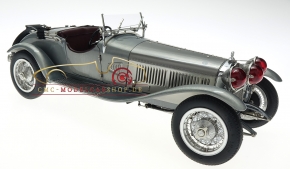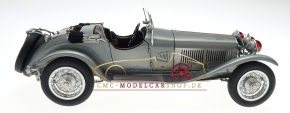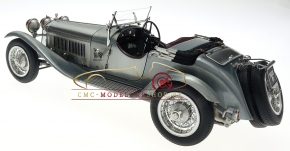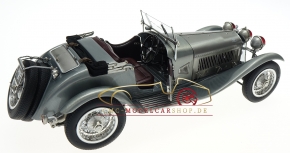product description
A masterpiece of architecture model:
M-142 CMC Alfa-Romeo 6C 1750 GS 1930 Clear Finish
The Gran Sport was the most fascinating and successful car of the 6C 1750 series, and it war so named in 1930 in order do dinginguish it from the supercharged Super Sport of the previous year. The Gran Sport contributed significantly to the sporty image of Alfa Romeo in the beginning of the 1930's.
With this clear finish edition of the 6C 1750 Gran Sport(limited to 1,000 untis only worldwide), CMC presents a rarity with a look that sets the miniature apart from what is a standard practice.
Upon looking at this CMC miniature, one cannot but realize how beautiful the model is without a colored finish on. There is a newly-gained aura and freshly-engendered charisma that put this miniature in bold contrast with painted ones and, therefore, in a class of its own convicingly.
Particularly evident in the clear finish edition are the high-quality materials and extraordinary craftmanship that go into its making, and the add to its value as a collector's item.
To protec the surfaces from discoloration or erosion of patina, they are sealed with a clear coat.
The Gran Sport was the most fascinating and successful car of the 6C 1750 series, and it war so named in 1930 in order do dinginguish it from the supercharged Super Sport of the previous year. The Gran Sport contributed significantly to the sporty image of Alfa Romeo in the beginning of the 1930's.
With this clear finish edition of the 6C 1750 Gran Sport(limited to 1,000 untis only worldwide), CMC presents a rarity with a look that sets the miniature apart from what is a standard practice.
Upon looking at this CMC miniature, one cannot but realize how beautiful the model is without a colored finish on. There is a newly-gained aura and freshly-engendered charisma that put this miniature in bold contrast with painted ones and, therefore, in a class of its own convicingly.
Particularly evident in the clear finish edition are the high-quality materials and extraordinary craftmanship that go into its making, and the add to its value as a collector's item.
To protec the surfaces from discoloration or erosion of patina, they are sealed with a clear coat.
Technical data of the CMC-model:
- Model: Assembled, handmade precision model
- Manufacturer: CMC GmbH, Classic Model Cars, Germany
- Scale: 1:18
- Art.-No.: M-142
- Color: clear finish
- Parts: 1,800
- Limited Edition: 1,000 pcs
Model Details:
- Hand-assembled precision metal model with right-hand drive, built from 1,800 single parts, of which 1,311 are made of metal
- True-to-scale, authentic replication of the Spyder body customized by the renowned coachbuilder Zagato
- Metal framing of multiple body parts
- Highly detailed 6-cylinder in-line engine, complete with all aggregates, pipes and cabling in addition to a front-mounted Roots supercharger and accessories
- Distinctiv Alfa Romeo front end with the famous triple-headlight unit
- Headlights fitted with mesh guards against stone-chip damages. The red caps are removable
- Double-winged engine hood that opens to rest on metal studs
- Finely-woven metal grille to protect the radiator fins
- Windshield with a semi-fixed metal mounting-frame
- Functional doors mounted on finely-recreated hinges
- One lateral filler of the oil tank located within the cockpit, and one rear filler of the fuel tank made of stainless steel, each with a flip-open cap
- Luggage space with a functional lid behind the folded textile top
- Highly-detailed cockpit with upholstered leather seats and door trimmings
- Precise recreation of the dashboard with all instruments and controls
- Functional brackets for holding the two spare wheels. Loosening a tommy screw releases the spare wheels
- Perfectly-wired wheels with a light alloy rim, stainless steel spokes and nipples
- Unscrew the central locking nuts (with side-dependent right- and left-hand threads) to remove the wheels
- Elaborate undercarriage, which reveals a "cast metal" type of front/rear axles as well as the fine detailing of the mechanical brake riggings, leaf springs, and friction-shock absorbers, all being made of metal
- Metal surfaces sealed with a clear coat
Description of the original vehicle:
The 6C 1750 GS was designed as a racing car, and it proved to be a cut above its contemporaneous rivals primarily because of its excellent acceleration on top of a simple chassis design and the reliability of mechanical components. Another contributing factor was the exceptional throttle response and revving of the engine. The well-tuned suspension, which was stiff but not too hard, enabled an energy-effective driving style. With a curb weight of 920 kg and an output of 85 hp at 4500/min, the Gran Sport reached 145 km/hr, an amazing speed for a 1930 car that was well below two liters of displacement. For most challenging races, Alfa Romeo equipped its official GS racing cars with fused cylinder heads and an eight-bearing crankshaft to muster 102 hp at 5000/min. Later on, as its curb weight was reduced to 840 kg, the 1930 GS was capable of reaching a top speed up to 170 km/hr.
Apparently, such technological improvements gave Tazio Nuvolari and his co-pilot Guidotti an advantage as they raced their 6C 1750 GS with starting no. 84 in the 1930 Mille Miglia endurance race. But their arch rival Achille Varzi was also driving a 6C 1750 GS, so a heated competition unfolded between them. Drivers of both cars exerted their skills to the utmost and even employed tricky maneuvers. Legend has it that under the cover of a nightfall, Nuvolari turned off the headlights as his car drew closer and closer to Varzi from behind. When he was right behind his opponent, Nuvolari suddenly switched on the three glaring headlights and surpassed a bedazzled Varzi at full speed to win the race.
Since then, the three headlights capped with red plastic covers have been one of the most distinctive features for identifying the pre-war racing models made by Alfa Romeo.
It should be mentioned that at the 1930 Mille Miglia, the first four places in the overall standings were all taken by Alfa factory cars, with the winner Tazio Nuvolari scoring an average speed of over 100 km/hour.
Apparently, such technological improvements gave Tazio Nuvolari and his co-pilot Guidotti an advantage as they raced their 6C 1750 GS with starting no. 84 in the 1930 Mille Miglia endurance race. But their arch rival Achille Varzi was also driving a 6C 1750 GS, so a heated competition unfolded between them. Drivers of both cars exerted their skills to the utmost and even employed tricky maneuvers. Legend has it that under the cover of a nightfall, Nuvolari turned off the headlights as his car drew closer and closer to Varzi from behind. When he was right behind his opponent, Nuvolari suddenly switched on the three glaring headlights and surpassed a bedazzled Varzi at full speed to win the race.
Since then, the three headlights capped with red plastic covers have been one of the most distinctive features for identifying the pre-war racing models made by Alfa Romeo.
It should be mentioned that at the 1930 Mille Miglia, the first four places in the overall standings were all taken by Alfa factory cars, with the winner Tazio Nuvolari scoring an average speed of over 100 km/hour.
Technical data of the original vehicle:
- Two-seater Spyder with a Zagato light-alloy body
- Steel box frame
- 6-cylinder in-line engine with dual overhead camshafts
- Maximum output: 85 hp at 4,500 rpm, 102 hp at 5,000 rpm (factory race cars 1930)
- Displacement: 1,752 cc
- Mixture preparation: Roots supercharger with Memini dual flat-flow carburetor
- Top speed: 145 Km/hr (85 hp), approx. 170 Km/hr (102 hp)
- Bore x stroke: 65 x 88 mm
- Wheel base: 2,745 mm
- Track front / rear: 1,380 / 1,380 mm
- Total weight: 920 Kg (85 hp), 840 Kg (102 hp)
More Alfa Romeo from CMC Classic Model Cars
Product safety - Manufacturer information (GPSR)
CMC GmbH & Co. KG, Stuttgarter Str. 106, 70736 Fellbach
Contact: www.cmc-modelcars.de
Sicherheitshinweis / Consigne sécurité / Safety warning:
Sammlermodell - Nicht für Kinder unter 14 Jahren geeignet
Modèle de collection - Ne convient pas aux enfants de moins de 14 ans.
Collector's model - Not suitable for children under 14 years of age
Review(s)












